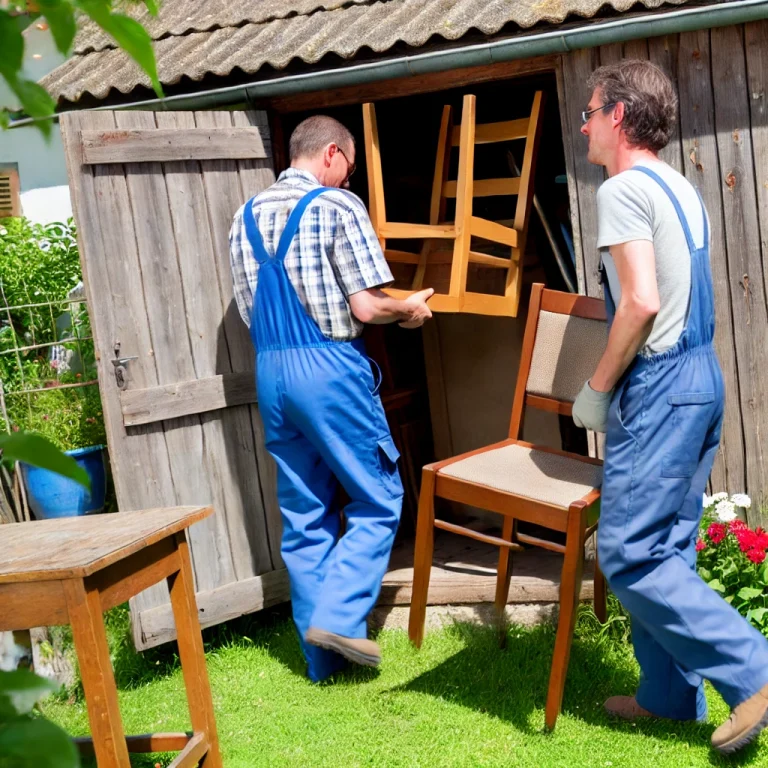What Exactly Means Shed Clearance
Shed clearance refers to the process of cleaning out and organising a shed by removing unwanted items, debris, and rubbish, ultimately transforming the space into a more functional and clean area. In the context of removing all the stuff you don’t need from your garden shed, specifically means the process of thoroughly emptying the shed of unnecessary or unwanted items. This involves identifying and removing anything that no longer serves a purpose, is broken, or simply takes up space, making the shed a more usable and organised area. Here’s a detailed breakdown of what shed clearance entails:
1. Assessment and Planning
- Evaluate the Current State: Begin by assessing what’s currently in the shed. Take note of items that are necessary and those that are simply taking up space.
- Plan the Clearance: Determine what needs to be removed, what can be kept, and how you want the space to be afterward.
2. Sorting Items
- Categorise Belongings: Sort through all items in the shed. Create categories such as “Keep,” “Dispose of,” “Recycle,” and “Donate/Sell.”
- Identify Rubbish: This includes broken tools, old materials, damaged furniture, and any other items that are no longer useful. These should be the first to go.
3. Removing Rubbish
- Disposal Options: Arrange for the removal of rubbish. This can involve hiring a skip, taking items to a local waste facility, or arranging for a professional rubbish removal service.
- Recycle or Donate: For items that are still usable but not needed, consider recycling or donating them. Some items may even be sold if they have value.
4. Deep Cleaning
- Clean the Shed: Once the rubbish is removed, thoroughly clean the shed. Sweep out debris, dust shelves, and wipe down surfaces.
- Inspect the Shed: Look for any damage like leaks, rust, or mold, and address these issues to prevent further deterioration.
5. Reorganising the Space
- Make the Space Useful: Put in order the remaining items in a way that you space become more. Use shelving, hooks, and storage bins to keep things tidy.
- Create Zones: Designate specific areas for different types of items, such as gardening tools, sports equipment, or seasonal decorations.
- Label Everything: Label shelves and containers to make it easy to find things in the future.
6. Making the Space Bigger
- Reevaluate Space Usage: If your goal is to make the shed bigger, consider if there are items that can be stored elsewhere, such as in the garage or attic.
- Physical Expansion: In some cases, making the space bigger might involve structural changes, like adding shelving units or even extending the shed itself.
7. Maintenance Plan
- Keep It Organised: After clearing and making all in order, establish a regular maintenance plan to keep the shed tidy. This could be a seasonal check to remove unnecessary items and reorganise as needed.
By the end of a shed clearance, the space should be free of clutter, better organised, and possibly even physically larger, allowing for more efficient use of the shed. This makes it easier to find what you need, keeps the area safe, and ensures that the shed remains a valuable storage space.

What Kind Of Rubbish We Remove From Sheds?
A garden shed can accumulate a wide variety of rubbish over time, often becoming a storage space for items that are no longer useful or have outlived their purpose. We remove and dispsoe all types of rubbish found in a shed:
- Old Garden Tools: Broken or rusted tools like spades, rakes, shears, and lawnmowers that are no longer functional.
- Unused or Expired Paints and Chemicals: Leftover paint cans, pesticides, fertilisers, and other garden chemicals that may have expired or are no longer needed.
- Broken Furniture: Outdoor furniture that is damaged, worn out, or no longer in use, such as chairs, tables, and benches.
- Scrap Wood and Metal: Offcuts from DIY projects, old shelving, or metal parts that were saved for future use but never found a purpose.
- Garden Waste: Bags of soil, compost, old plant pots, and sometimes even decayed organic material that wasn’t disposed of properly.
- Old Appliances: Items like old lawnmowers, hedge trimmers, or other garden appliances that have broken down and are beyond repair.
- Miscellaneous Junk: Boxes of assorted items that have been stored away, including old toys, sports equipment, and other miscellaneous household items that no longer serve any purpose.
- Plastic and Metal Containers: Empty or damaged containers that once held tools, seeds, or other gardening supplies.
- Hazardous Materials: Sometimes sheds can store items like asbestos roof panels, old batteries, or fuel canisters, which require special disposal methods.
- Debris and General Waste: Accumulated rubbish from general use, including plastic wrappers, bags, broken pots, and other debris that may have been tossed into the shed over the years.
Proper disposal of these items is important, especially when it comes to hazardous materials, which should be handled according to local regulations to avoid environmental harm
